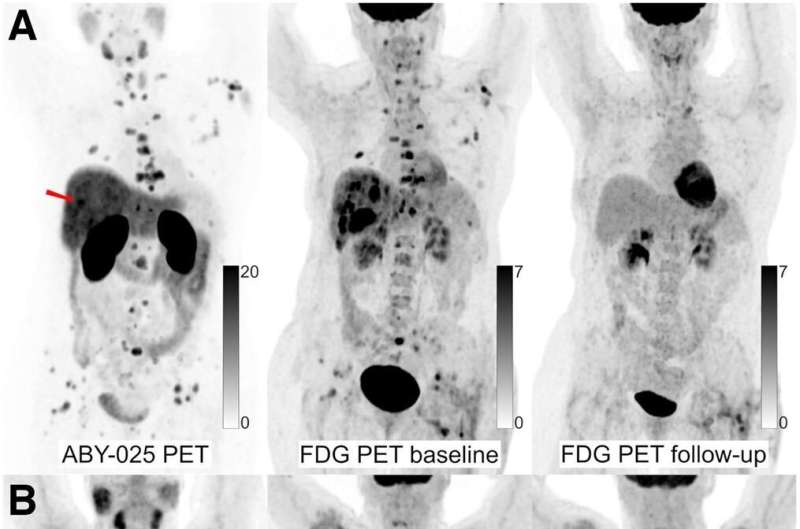This article has been reviewed according to Science X's editorial process and policies. Editors have highlighted the following attributes while ensuring the content's credibility:
fact-checked
peer-reviewed publication
trusted source
proofread
Whole-body PET/CT predicts response to HER2-targeted therapy in metastatic breast cancer patients

A new imaging agent, 68Ga-ABY-025, can predict early metabolic response to human epidermal growth factor receptor 2 (HER2)-targeted treatment in HER2-positive metastatic breast cancer patients, according to new research published in the Journal of Nuclear Medicine. By providing whole-body quantification of HER2 expression, 68Ga-ABY-025 PET/CT can play a valuable role in treatment planning and could spare patients from unnecessary drug-related side effects.
Up to 20% of breast cancer patients have HER2 overexpression, making HER2 an attractive therapy target for both new and recurring cases. However, since breast cancer is a heterogeneous disease and HER2 expression may vary within the same patient and over time, HER2-targeted treatment failure is common, and cure remains rare in metastatic disease.
"While HER2 status can be confirmed by biopsy results in early-stage breast cancer, it is more complicated in advanced disease where multiple metastases might have a heterogeneous HER2 expression," said Ali Alhuseinalkhudhur, MD, Ph.D. candidate in the Department of Immunology, Genetics, and Pathology at Uppsala University in Uppsala, Sweden. "Imaging the entire body rather than just the primary cancer site can give physicians a total estimate of HER2 expression so they can plan targeted therapies appropriately."
Researchers investigated 68Ga-ABY-025 PET as a noninvasive tool for whole-body HER2-receptor quantification. Forty patients with known positive HER2 status were included in the study: 19 with primary breast cancer and 21 with metastatic breast cancer (median of three previous treatments).
68Ga-ABY-025 PET/CT, 18F-FDG PET/CT, and core-needle biopsies from targeted lesions were performed at the baseline for each patient. 18F-FDG PET/CT was repeated after two cycles of therapy to calculate the directional change in tumor lesion glycolysis. Tracer uptake was measured in up to five of the largest lesions per patient, including the biopsied lesion. Standardized uptake values from 68Ga-ABY-025 PET/CT were then compared with the biopsied HER2 status and change in tumor lesion glycolysis.
68Ga-ABY-025 PET/CT successfully enabled quantification of HER2 expression, and uptake correlated significantly with metabolic response among patients, particularly in those with metastatic breast cancer. Also, an inverse association was found between the number of previous treatments and the metabolic response to the current treatment; the more treatments received, the higher the 68Ga-ABY-025 required to induce a metabolic response.
"The ability of 68Ga-ABY-025 PET/CT to provide a whole-body visualization of HER2 expression and to predict metabolic response is advantageous and exceeded the biopsy-based approach for metastatic breast cancer patients," noted Alhuseinalkhudhur. "HER2-based imaging tools might provide a solution in situations where biopsies cannot be performed safely or when biopsy results are inconsistent. In addition, a PET-based approach to evaluate the appropriateness of targeted therapy might help avoid unnecessary side effects and might provide a more personalized opportunity for timely therapy corrections."
He continued, "Our work is a strong example of the development toward personalized medicine. We hope that the value of quantification of biomarkers such as HER2 expression in cancer patients will be appreciated to a larger extent and introduced into nuclear medicine practice for both diagnostic imaging and therapy."
More information: Ali Alhuseinalkhudhur et al, Human Epidermal Growth Factor Receptor 2–Targeting [68Ga]Ga-ABY-025 PET/CT Predicts Early Metabolic Response in Metastatic Breast Cancer, Journal of Nuclear Medicine (2023). DOI: 10.2967/jnumed.122.265364





















